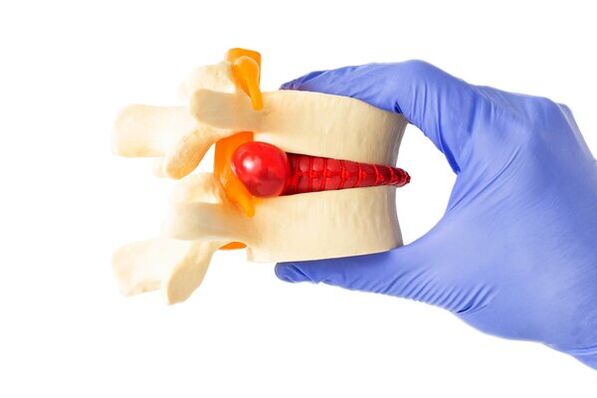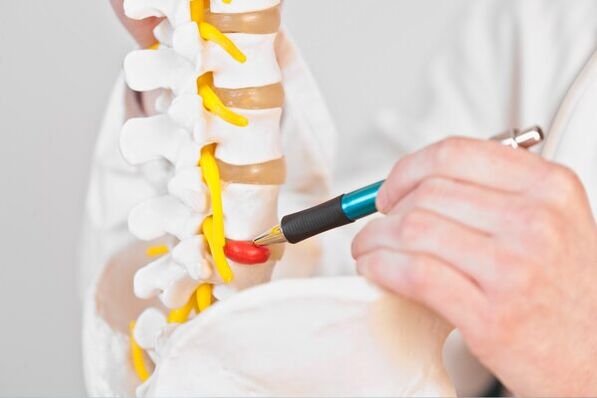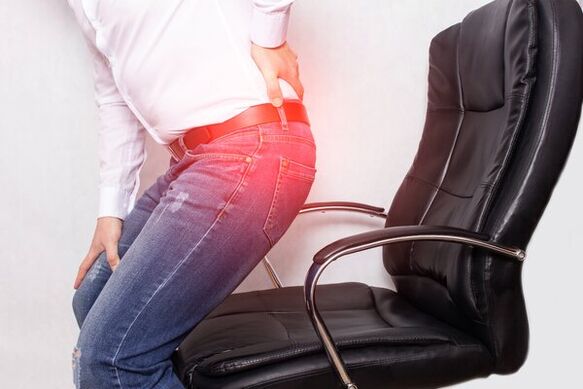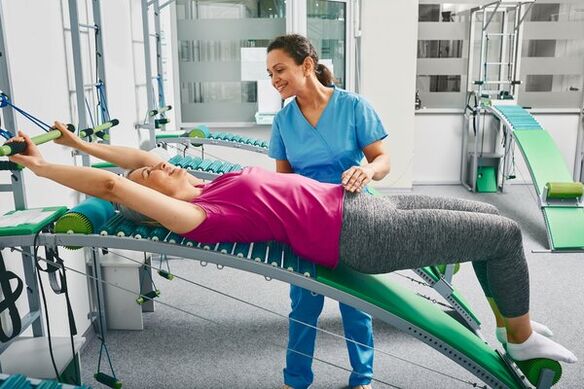Osteochondrosis is a common spinal disease that affects the intervertebral discs and cartilage. The cervical and lumbar regions are more sensitive to such processes. Osteochondrosis of the lumbar region can cause constant pain in the lower back and significantly complicate a person's life. In the treatment of the disease, preference is given to conservative methods, surgical interventions are used only in extreme cases.
Causes of lumbar osteochondrosis

Osteochondrosis is not so much a disease as a natural phenomenon that results from age-related degenerative changes in the spine. Normally, the disc in the lumbar spine acts as a shock absorber between two vertebrae and allows the joints and spine to move easily. The outer part of the disc, the annulus fibrosus, surrounds the soft inner core of the disc, the nucleus pulposus. Every person's spinal discs undergo degenerative changes as they age, but not everyone develops symptoms.
Osteochondrosis is believed to begin with changes in the annulus fibrosus, intervertebral disc and subchondral bone. The annulus fibrosus loses water, making it less able to withstand daily loads on the spine, distributing them poorly. Overloading the posterior part of the vertebra leads to arthritis of the facet joints and hypertrophy (growth, with the formation of osteophytes - bony growths) of the vertebral bodies adjacent to the affected disc.
Reference! According to statistics, 30% of people aged 30 to 50 have some degree of spinal disc degradation.
There are two main pathophysiological causes of pain in lumbar osteochondrosis. One possible cause of the pain is inflammation of the nerves resulting from the rupture of the outer part of the disc and leakage of the inner core. Inflammatory proteins are released and irritate nerve tissues.
According to the second reason, the vertebrae, due to age-related deformation, are no longer able to effectively absorb the load. This causes abnormal movement of the spine and causes a painful spasm of the back muscles that attempt to stabilize the spine.
Osteochondrosis can cause the destruction of segments of the spine, leading to radiculitis. Risk factors that trigger and accelerate degenerative processes in the spine are:
- Hereditary predisposition to diseases of the musculoskeletal system;
- Smoking;
- Previous injuries;
- Hormonal and vascular disorders;
- Excess body weight;
- Muscles that are too weak and do not provide the necessary support to the spine;
- Professional activities associated with heavy physical labor (athletes, loaders).
Stages of development of lumbar osteochondrosis

Disorders of the intervertebral discs, leading to their degeneration and destruction, occur gradually. The entire pathological process goes through several stages, according to which the stages (or degrees) of lumbar osteochondrosis are distinguished:
- The first stage (degree) is characterized by mild symptoms. Painful sensations develop against the background of irritation of the nerve endings by the nucleus pulposus, penetrating into the cracks of the annulus fibrosus.
- The second stage is characterized by a displacement of the upper vertebra relative to the lower vertebra, due to cracking of the core and the ring. These pathological processes, in addition to pain during movement, cause the appearance of neurological symptoms, sensations of numbness and instability of the affected area.
- The third stage is characterized by increased pain and the appearance of intervertebral disc herniations, due to a violation of the integrity of the annulus fibrosus. Pain, sensory impairments, and muscle weakness interfere with daily tasks. Due to pinching of nerve roots, the functioning of the urinary and intestinal systems may be disrupted.
- The fourth stage corresponds to the complete destruction of the intervertebral discs, they become fibrous and osteochondral outgrowths of the vertebral bodies cause immobility of the spine in this section.
Symptoms of lumbar osteochondrosis
To get started, get advice from specialists:
- Neurologist
- Orthopedist
- Therapist
The main symptom of lumbar and sacral osteochondrosis is pain. It usually gets worse when you sit for long periods of time, or when you turn, bend your spine, or lift a load. The pain can radiate to the leg, groin and be accompanied by a feeling of numbness and weakness. Moderate, aching, dull pain may be followed by attacks of exacerbation.
The symptoms directly depend on the stage of development of the pathology:
- Initially, when degenerative changes are just beginning to appear, symptoms are minimal.
- The intermediate stage, characterized by a weakening of the annulus fibrosus, can already manifest itself as lower back pain.
- At a later stage, when fibrosis develops in the structures and osteophytes are formed, the pain becomes less pronounced, but the mobility of the spine significantly decreases.
Lower back sensitivity may be increased to touch. Characteristic shooting pains in the buttocks, thighs and a tingling sensation are signs of pinched nerve roots that occur as a result of degenerative changes in the disc. Patients with lumbar osteochondrosis have difficulty bending forward, backward and to the sides. Osteochondrosis can be complicated by disc herniation and narrowing of the spinal canal, accompanied by the appearance of additional symptoms.
Diagnosis of lumbar osteochondrosis

Establishing a diagnosis begins with collecting anamnesis, interview and examination of the patient. The specialist will be interested in your complaints, your physical activity, the presence of old injuries, bad habits and cases of illness in relatives. During a physical exam, the doctor palpates (feels) the lower spine, looking for tender areas, inflammation, or any abnormalities. He can also check sensations and perform motor tests.
The most popular method for diagnosing lumbar osteochondrosis is X-ray examination. The image will show the presence of osteophytes, narrowing of the joint space of the disc, or the so-called "empty" symptom, whenGas bubbles are detected in the thickness of the disc. Other methods used are:
- MRI showing hydration (the degree of water saturation), the shape of the discs, their height, which helps identify pinched nerves.
- Scanner, which allows you to study the condition of tissues in detail and diagnose disorders in the early stages.
- Provocative discography used to determine the location of the affected disc.
Reference! MRI is a fairly accurate diagnostic method, but it cannot detect rupture of the outer rings of the disc.
Methods for treating lumbar osteochondrosis
The preferred treatment for lumbar degenerative disc disease associated with chronic pain is conservative treatment including physical therapy, exercise, and medications. For patients suffering from lumbar osteochondrosis, it is recommended:
- A daily routine that includes sufficient rest and adequate physical activity;
- Regular physical exercise aimed at strengthening muscles;
- Lifestyle adjustments, including nutritional review and weight loss.
Physiotherapy

Various physiotherapeutic techniques have been used successfully to reduce lower back pain. Physiotherapy promotes disc regeneration processes, stimulates metabolic and transport processes, prevents the formation of adhesions and other damage.
Physiotherapeutic methods used to treat osteochondrosis of the spine include:
- Electrical stimulation. Electrical impulses help relieve back pain and improve blood circulation in the affected spine.
- Ultrasound therapy. Ultrasound waves can penetrate deep layers of tissue and help relieve inflammation and pain.
- Magnetotherapy. Magnetic fields can improve blood circulation and metabolic processes in tissues, thereby promoting their regeneration.
- Laser therapy. Laser beams can help relieve pain, stimulate blood circulation and stimulate tissue regeneration.
- Ultraphonophoresis. This method combines ultrasound therapy with the use of drugs that penetrate deep tissue layers and help relieve inflammation and pain.
Important! Contrary to popular belief, osteochondrosis can and should be treated. Without treatment, it will become a source of chronic pain and can lead to many problems, including disruption of the functioning of internal organs.
Medical treatment
To relieve pain that interferes with daily activities, patients are prescribed painkillers and nonsteroidal anti-inflammatory drugs. Depending on the indications, the doctor may prescribe more powerful medications: muscle relaxants, steroids and narcotic pain relievers. Therapeutic blocks are administered with local anesthetics and glucocorticoids to relieve severe pain.
Surgery
Much less frequently, surgical intervention is used for osteochondrosis of the lumbar region. This may include disc replacement or lumbar spine fusion (creating conditions for two vertebrae to fuse together, while pain is reduced by eliminating movement in that part of the spine).
If spinal movement is significantly impaired, special intervertebral spacers may be installed. For patients who do not respond to all other treatments, a lumbar total disc replacement may be performed.
Treatment of lumbar osteochondrosis at home
The most effective thing you can do at home to maintain functionality and control pain is to exercise. They will increase the flow of blood, oxygen and nutrients to the spine, helping to keep the cartilage hydrated and the spine flexible for as long as possible. Additionally, during exercise, endorphins are released, which are natural pain relievers.
Frequent position changes also provide relief. Certain poses help to cope with a pain attack: kneel, lie down, lie down. A short rest is necessary and beneficial, but prolonged bed rest only aggravates the situation. It is important to stay active to prevent the disease from progressing. Patients with lumbar osteochondrosis benefit from walking, swimming, cycling, yoga, Pilates, stretching exercises and strengthening the muscle corset. The following measures are also useful:
- Applying heat to the lower back improves blood circulation and relieves muscle spasms and tension.
- Ice packs will help relieve pain and reduce inflammation.
- Massage also relaxes muscles, relieves spasms and reduces pressure on the spine, thereby relieving pain. By increasing blood circulation in this area, metabolic processes are improved and tissues are enriched with oxygen.
- Use of orthopedic mattresses and pillows. They will help maintain the correct spinal position during sleep.
- Correct distribution of the load on the spine. When lifting heavy objects, you must use proper lifting technique to avoid stressing the lumbar spine.
- Adequate nutrition. A balanced diet rich in calcium and vitamins will help maintain healthy bones and joints.
However, if you experience pain or other symptoms, before starting treatment for osteochondrosis at home, you should consult your doctor to receive more accurate recommendations and assess the condition of the spine.
Which doctor should I contact in case of lumbar osteochondrosis?
If symptoms characteristic of lumbar osteochondrosis appear, it is recommended to consult a neurologist or orthopedist. If you suffer from lower back pain, you can also make an appointment with a therapist. He will prescribe the necessary tests to make a diagnosis and refer you to a specialist.
Treatment of lumbar osteochondrosis
Specialists in the clinic closest to your city or other locality are ready to understand the reasons and help you cope with pain. Doctors usually have extensive clinical experience and have mastered all modern methods of treatment and diagnosis of osteochondrosis in women and men. In essence, the convenient location, excellent equipment and versatility of institutions are a priority of modern medicine, which allows you to quickly undergo any examination and restore the health of the musculoskeletal system. You can make an appointment by calling a clinic convenient for you, as well as on the website by filling out the online form.
Prevention of lumbar osteochondrosis

Effective methods for preventing lumbar osteochondrosis are:
- Regular physical activity. Keep in good physical shape. Strengthen your back muscles. Stretching and back strengthening exercises will help keep your spine healthy.
- Reduce stress on the spine: Avoid unnecessary stress on the spine. When lifting heavy objects, use proper lifting technique.
- Posture correction: ensures correct posture. Sit up and stand up straight, don't slouch. Choose an orthopedic pillow and mattress for sleeping to maintain the correct position of the spine during rest. Buy quality shoes with good cushioning and support.
- Take care of your back support by using orthopedic chairs if, due to the nature of your profession, you are required to sit for long periods of time. Avoid staying in the same position for a long time. Take regular breaks and stretch your spine.
- Watch your weight. Excess weight can put extra pressure on the spine.
- Avoid uncontrolled movements and back injuries. Be careful when playing sports or physical activity.
- Stop smoking, which can harm your spinal health.
By following simple recommendations, you can lead an active and fulfilling life, minimizing the risk of back pain. If you are already experiencing symptoms, pain in the lumbar spine, be sure to see a doctor for diagnosis and treatment.
























